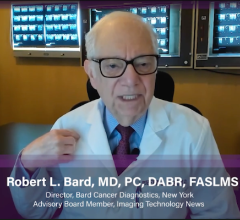
March 27, 2019 — Training interventional radiologists to perform endovascular thrombectomies results in positive outcomes for patients experiencing stroke, according to a study presented at the Society of Interventional Radiology (SIR) Annual Scientific Meeting, March 23-28 in Austin, Texas.1 Expanding access to this treatment provides patients timely access to this gold-standard treatment.
“With a limited availability of providers, thrombectomy is only available to 2 to 3 percent of eligible patients in the United States,” said Kelvin Hong, M.D., FSIR, associate professor and division chief of interventional radiology at Johns Hopkins University. “Patients don’t plan where and when they have a stroke. Our model of training board-certified interventional radiologists can expand access to quality, evidence-based care, and reduce the lifelong disability associated with stroke.”
Thrombectomy — a treatment that clears a clogged artery in the brain — increases the survival rates among those suffering an acute ischemic stroke, reduces the likelihood of resulting disabilities and speeds function recovery. However, to gain these benefits, thrombectomies must be initiated and performed quickly. Many hospitals do not have providers available to perform these treatments and must transfer patients to a facility where they can get this care, losing valuable time.
To determine an efficient and sustainable way to expand access to thrombectomy, researchers from Johns Hopkins University developed an interventional radiology stroke team at Suburban Hospital, a community hospital in Montgomery County, Md., a suburb of Washington, D.C. The team consisted of four interventional radiologists who were specially trained by a neurointerventional radiologist for six months. The entire team was available 24 hours a day, seven days a week, with the neurointerventional radiologist helicoptered to the hospital for every case during this training period.
“We looked to change the dynamic in stroke care, where instead of transporting medically fragile patients, we brought in a specialist to perform this care and build the infrastructure necessary to provide this treatment to a community with limited stroke care resources,” said Ferdinand Hui, M.D., a neurointerventional radiologist and associate professor of radiology and radiological science at Johns Hopkins University. “In a situation where every minute counts, we wanted to design our program to provide the training and organization necessary to bring 24/7 highly trained stroke interventionalists online as quickly as possible.”
Once the interventional radiologists were conducting the treatments independently, researchers measured the technical success of the thrombectomies performed by the newly trained physicians in 35 stroke cases using the Thrombolysis in Cerebral Infarction (TICI) scale. They found no significant differences compared to the 2016 HERMES meta-analysis2 of endovascular thrombectomy outcomes performed by other practitioners, such as neurointerventional radiologists and neurosurgeons. Additionally, 14 percent mortality in the first 90 days after the procedure was similar to 15.3 percent 90-day mortality among patients at stroke centers evaluated through the Journal of the American Medical Association-published HERMES trial.3 The median interval from symptom onset to the point when blood flow was restored was 325 minutes, compared to 285 minutes in previous research.
Researchers plan to further evaluate the technical outcomes and time metrics in a second-year study, with a goal of further reducing the time to treat each patient by improving efficiency and optimization year over year.
A limitation of the study may be in whether hospitals of varying sizes and resources can reproduce the program with the same outcomes. The research team plans to re-evaluate the program after two years of data collection.
For more information: www.sirmeeting.org
Related Stroke Content
VIDEO: Creating and Operating a Mobile Stroke Unit
Northwestern Medicine Mobile Stroke Unit Delivers Life-Saving Care 30 Minutes Sooner
References
1. Abstract 294: Technical Outcomes and Early Experience of a Centrifugally-Trained Interventional Radiology Stroke Service. Huh E., Hui F., Bhagat N., et al. SIR Annual Scientific Meeting, March 23–28, 2019. www.sirmeeting.org.


 July 25, 2024
July 25, 2024 








